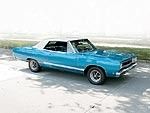
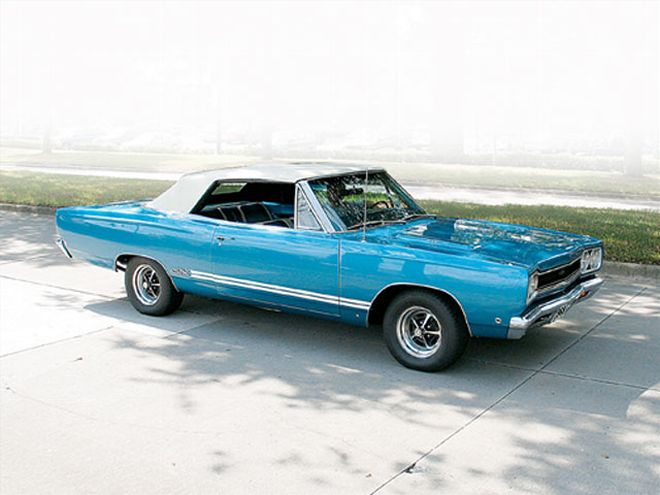
Selecting the proper wheels and tires to adorn your Mopar is probably one of the biggest decisions you'll make when fixing up your car. Nothing, besides paint, has more of an impact on your car's appearance than the wheels and tires. A nice set of wheels and tires will make virtually any car look good, no matter what the condition. The only real problem with choosing wheels and tires (other than forking over the cash) is that there are so many choices. How do you decide which wheel and tire combination will give your car the look and stance that you desire? Are you after a stock look or do you prefer aftermarket wheels? Will you use tires of the factory recommended size or will you upgrade to a larger tire to achieve a higher level of performance? In some cases the performance level you wish to achieve will dictate the wheels and tires you should consider for your car. While wheel style is usually a matter of individual preference, there is often more than one choice of wheel in the style you like. Then there is the issue of tire sizes. How do you measure for tires that will give you the maximum performance, while still fitting within the confines of your car's fenders without rubbing? And what the heck do all of those numbers on the sidewall of the tire mean? Well, we're here to help. Follow along as we discuss all aspects of tire and wheel selection, decipher those numbers and letters on the side of the tire, and show you how to correctly measure for tires that will fit your application and give you the performance you desire.
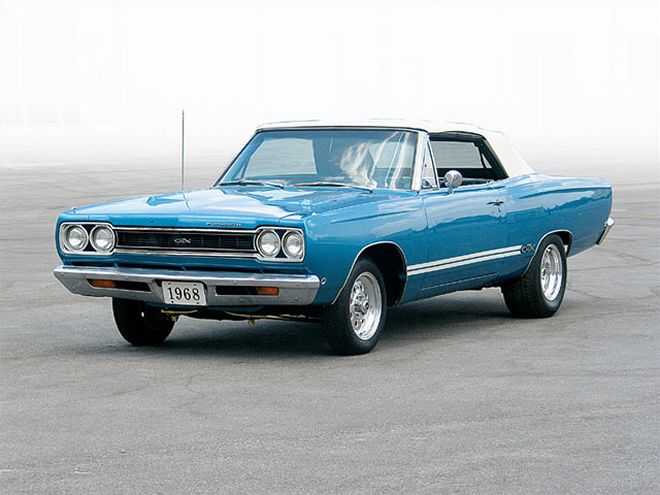 The right wheels and tires can radically change the look and performance of your Mopar. Notice how the same car takes on a whole new stance and attitude when the wheels and tires are changed from the factory Magnum 500s to a set of Weld Drag Lites.
The right wheels and tires can radically change the look and performance of your Mopar. Notice how the same car takes on a whole new stance and attitude when the wheels and tires are changed from the factory Magnum 500s to a set of Weld Drag Lites.
Selecting Wheels
When selecting wheels for your Mopar, the first thing to consider is the style of wheel that will achieve the all-around look you envision for your car. If you're going for a stock restored look, a factory wheel may suit your needs. Factory wheels such as the Rallye or Magnum 500 are a good option for a sportier look than hubcaps, and 15- by 8-inch versions can accommodate substantially larger tires than the tires that came stock on your car. We love the factory appearance of these wheels and have even had them widened to accommodate larger back tires while still appearing stock from the side. A consideration of factory wheels is they may not fit over disc brakes, especially larger aftermarket units. Also, factory steel wheels are nearly always heavier than their aluminum aftermarket counterparts. Since wheels constitute rotating mass, their weight has a more dramatic effect on performance than static mass, so a car's performance is nearly always increased by lightening the wheels. This dilemma used to force a car owner to choose between the look of a factory wheel and the performance of an aftermarket aluminum piece. Car owners now have a third choice, which actually combines the look of a factory wheel with the performance of a billet aluminum unit. This new choice is provided by a company called Wheel Vintiques.
Wheel Vintiques recognized the market for high-quality aftermarket wheels that have the same appearance as the wheels you could get from the factory, and has an entire line of both Magnum 500 and Chrysler Rallye wheels spun from billet aluminum or steel. Also recognizing the performance trend of larger diameter wheels combined with wide, low-profile tires, they made their wheels available in diameters up to twenty inches. While we do appreciate the performance these large wheels and low-profile tires provide, the performance comes at a price. Much of a car's ride quality is provided by the sidewall of the tire, which acts like a shock absorber of sorts cushioning the bumps of the road. With less sidewall available in a low-profile tire, there is less material to cushion the blow of bumps and potholes on the road, so ride quality will suffer. Also, if the suspension of your Mopar is stock, these low-profile tires will outperform the suspension capabilities of your car, and the benefits (other than appearance) will be minimal. For cars with suspension upgrades such as sway bars, large disc brake systems, and heavy-duty leaf springs and torsion bars, however, the handling, stopping, and acceleration benefits of these large diameter wheels and low-profile tires can be dramatic. Cars configured with aftermarket suspension and tall wheels can handle nearly as nimbly as new sports cars with only subtle appearance differences from stock, making these wheels a great choice for g-machines. Once your wheel style and diameter is chosen, the job isn't finished. Wheel width and offset, or back-spacing, must also be carefully chosen before tire selection can be made.
Rim Width, Diameter, and Backspacing
When choosing a wheel, rim width is an important consideration. As a general rule, the rim width should be different from the tire's tread width by no more than one inch. So if you want to run 9 inches of tread width, a rim width between 8 and 10 inches will work. Ideally the rim width should closely match the tread width of the tire. Rims that are wider than the tire's tread may work, but the tire's height will be shortened, and the tire may not perform up to its potential. Too narrow a rim will increase the tire's sidewall height and will certainly lead to accelerated wear especially at the edges of the tread. Factory rims came in widths from less than 6 inches, to 8 inches in some 15-inch Rallye wheels. Police car wheels and most Magnum 500 pieces measure in at 7 inches. Aftermarket wheels are available in many widths, offering the ability to optimize your car's available fender space to maximize traction for handling, stopping, and acceleration. When measuring rim width remember that it is the distance between the two lips of the wheel where the tire's beads seat, not the maximum width of the wheel.
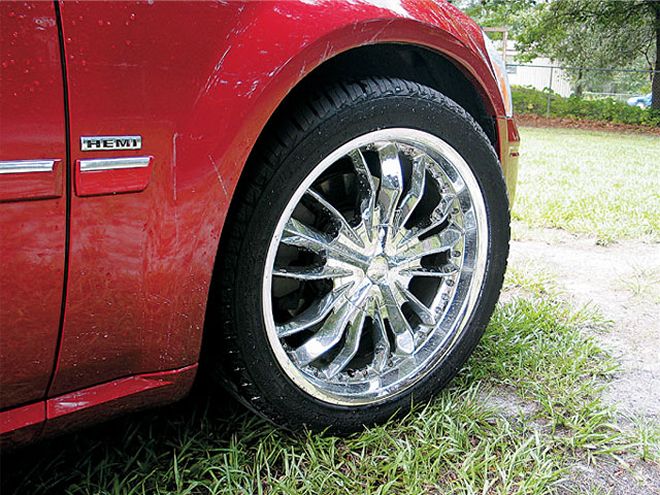 The newest trend in wheels is large diameter rims with wide, low-profile tires. While we aren't so sure about this look for a vintage musclecar, we do admit it's a good look for Mopar's most recent lineup, such as the Charger, 300, or Magnum.
The newest trend in wheels is large diameter rims with wide, low-profile tires. While we aren't so sure about this look for a vintage musclecar, we do admit it's a good look for Mopar's most recent lineup, such as the Charger, 300, or Magnum.
One of the most important considerations when ordering a wheel for your car is the backspacing of the wheel. The backspacing is the distance between the wheel's flange where it bolts onto the axle, drum, or rotor, and the innermost rim lip where the bead of the tire seats. Measuring the car to see what backspacing is ideal is actually easier than you may think and only requires a straight edge (metal ruler) and a tape measure. At the rear, the car is jacked up so the rearend housing can be supported on a jackstand, which places the rearend in the position it would be in when the car is resting on its wheels. The metal ruler is then placed on the axle flange where the wheel would rest. The tape measure is now used to determine how much offset, or backspacing, is needed to center the tire in the wheel opening. Be sure to measure for backspacing at the maximum diameter of the tire you'll be using and take into consideration both the inner and outer wheelwell dimensions, as well as suspension components such as leaf springs. We use the section width or measured maximum width of the tire as a reference for this measurement. Also carefully consider what will happen as the car's suspension is exercised; you'll want plenty of clearance when the suspension travels to its limits as well.
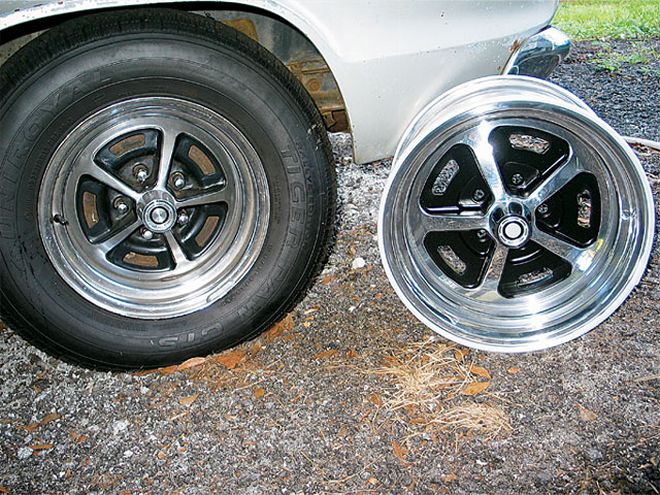 Once you've selected a style of wheel for your car, the choices are not necessarily over. Wheel Vintiques offers factory appearing wheels like the one on the right that are made from either steel or billet aluminum. These wheels are available in many diameter and back-spacing configurations that weren't available from the factory.
Once you've selected a style of wheel for your car, the choices are not necessarily over. Wheel Vintiques offers factory appearing wheels like the one on the right that are made from either steel or billet aluminum. These wheels are available in many diameter and back-spacing configurations that weren't available from the factory.
Measuring the front of the car for proper wheel width and backspacing requires a little more work than the rear. Since the front wheels turn side to side, clearance issues can occur if the measurements are not taken properly. We again start by placing a straight edge on the flange of the rotor or drum, and then we use our tape measure to determine the proper backspacing, tread or section width, and rim width that will work in our application. This can be a time consuming task as multiple measurements need to be taken with the steering turned fully in each direction. Again, the car's weight should be on the suspension so the measurements are more accurate. Also be sure to take suspension travel into consideration when measuring for tires. Just because a tire will fit when the car is sitting still doesn't mean it won't rub when the car is loaded and going over bumps, so be conservative and take the time to measure accurately. When rim width and backspacing are determined, be sure to take the suspension components, especially the upper control arm, into consideration. The backspacing of a Mopar's front wheels is usually limited by the upper control arm or disc brake caliper unless very large diameter wheels are used.
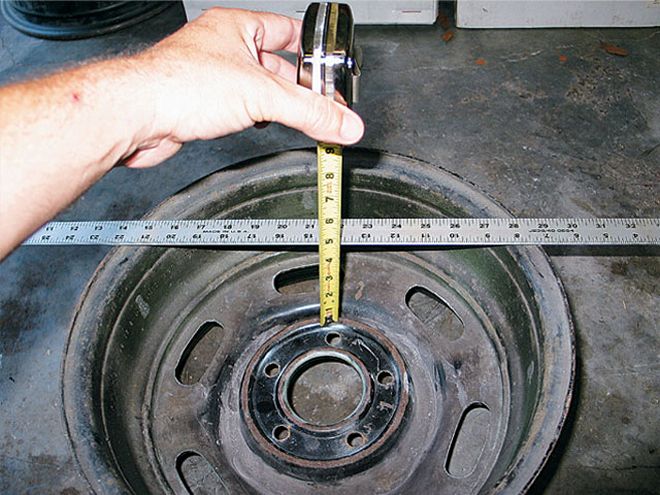 Rim width is an important factor of selecting wheels, as is the offset or back-spacing of the wheel. Factory wheels came in several widths and back-spacing configurations. This 15- by 7-inch factory police car wheel has four inches of back spacing.
Rim width is an important factor of selecting wheels, as is the offset or back-spacing of the wheel. Factory wheels came in several widths and back-spacing configurations. This 15- by 7-inch factory police car wheel has four inches of back spacing.
Tire Height, Width, and Aspect Ratio
With all the measuring completed and our wheels properly chosen for diameter, width, and backspacing, we can order our tires, right? Well, we're not ready to order yet. All of our measuring for tire and rim fitment has been in inches, the standard form of measurement in the United States. If you've measured everything like we did, you probably have a diameter and width in inches of the tire you'd like to have. Unfortunately, most tire companies list their tires in the modern "P-metric" format and don't give the tire's dimensions in inches. Luckily, there is a formula that will derive the tire height in inches from the P-metric coding on the side of the tire, but first let's explain what the P-metric coding numbers actually mean. As an example, we'll use a common upgraded rear tire for B-body Mopars, the 275/60R15. The first number, 275, is the section width in millimeters of the tire. The next number, 60, is the aspect ratio of the tire or the ratio between the height and section width of the tire. In other words, the sidewall of the tire will be 60 percent of the tire's width, giving this tire a shorter, or lower, profile sidewall than the same width tire with a 70- or 75-aspect ratio. But how do we convert these numbers to inches? Knowing how a tire's dimensions are defined is the first step.
P275/60R15
Modern tires are sized using the P-metric format and have a letter or series of letters before the first numbers on the tire. These letters designate the intended use of the tire. P is for passenger vehicles, LT for light trucks, and ST for special trailer service. If a tire's numbers are followed by a C, it designates the tire is for commercial use and will usually bear a higher load rating than standard tires.
P275/60R15
Following the letters on the tire is a series of three numbers indicating the tire's section width in millimeters. The section width is the maximum width of the tires cross section, or sidewall-to-sidewall, when mounted to a rim of a specific size. Converting the section width number to inches can be accomplished easily by dividing the number of millimeters in the section width by 25.4 to obtain the dimension in inches. Using the same example of a P275/60R15 tire, dividing the 275mm section width by 25.4 gives us a section width of 10.82 inches. This will be the maximum width of the tire from sidewall-to-sidewall, but does NOT take into consideration any raised lettering on the tire, so be sure to add the appropriate amount to the section width if your tires have raised letters.
P275/60R15
The next two digits on a tire's sidewall typically follow a slash mark and define the tire's sidewall aspect ratio. This number indicates, in a percentage, the tire's sidewall height from rim to tread as it relates to the section width of the tire. In our P275/60R15 example, the tire's sidewall height would be 60 percent of its section width. Since we know the section width is 275 mm, or 10.82 inches (275 divided by 25.4), multiply that number by .60 (sixty percent) to get a sidewall height of 165 mm, or 6.49 inches. Since there is a sidewall at both the top and bottom of the tire, by doubling the sidewall (6.49x2) and adding it to the rim diameter (15), we can derive the total height of the tire (6.49x2+15) = 27.98 inches. The height of a tire, in inches, can also be derived from its P-metric code by using the following formula: H (height) = (Wx(ratio/100)x.03937x2) + rim diameter. W is the tire's section width in millimeters, and rim diameter is in inches. By plugging in our P275/60R15 example we do the math as follows: H = (275x(60/100 x.03937x2) + 15. Using a calculator, we derive the tire height to be 27.99 inches. This factor will work for any P-metric tire and is a useful way to determine the overall height of P-metric tires in inches, which is the way we measured our car for tire fitment.
P275/60R15
The letter following the aspect ratio on the sidewall of the tire simply has to do with the construction of the tire. "R" indicates the tire is of radial (R) construction, that is, the tire's body plies "radiate" out from the imaginary center of the wheel. This is by far the most common type of tire construction representing over 98 percent of all tires sold today. If a "D" is found in this position, it indicates the tire's plies crisscross on a diagonal (D), and the tire is a bias-ply construction. These tires are typically used on light-duty trucks or for spare tire applications. A "B" in this position identifies that the tire not only has crisscrossed plies, but that it also is reinforced with belts under the tread area. This type of construction is called belted (B) and is nearly extinct. If a "Z" is found in this area before the construction designation (P275/60ZR15) it indicates the tire has a "Z" speed rating. Only tires with a "Z" rating will have the rating indicated on the sidewall.
P275/60R15
The final two-digit code on the sidewall indicates the rim size the tire is designed to fit, in our case a 15-inch rim.
Load Index and Speed Rating
Two more important considerations when considering tires are the load index and the speed rating of the tires. The load index quite simply refers to how much weight a tire can carry. Some tires have the load index in pounds stamped into the side of the tire, but most have a coded load index. Most tire manufacturers have a load index chart posted on their web site that will give a numerical value, in pounds, for the load index of the tire. Once the value, in pounds, is determined, simply multiply that number by four to get the maximum load-carrying capacity of your set of tires. It is never a good idea to put tires on your car that have a lower load index than the original equipment.
The speed rating given a particular tire is issued by the U.S. government and is based on how well a tire reaches and sustained a specific speed. Tires with a higher speed rating will generally provide better high-speed handling, so if better cornering response is desired try a tire with a higher speed rating. Tires with a "Z" speed rating (the highest speed rating) will be indicated as stated in the P-metric coding. Tires with a lower than "Z" rating will be indicated in the tire's service description, which is a series of letters/numbers immediately following the P-metric coding. For example, a tire with a "S" speed rating may be coded as: P275/60R15 91S, the S being the speed rating of the tire. Always remember a tire's speed rating depicts the speed at which it is tested, not the recommended or continuous speed limitation of the tire. Also, never mix tires of different speed ratings on your vehicle as serious handling problems could result. For a complete list of alphabetic speed ratings and their corresponding speeds please check the sidebar in this article.
Temperature Grade
The temperature grade of a tire is also indicated on the tire's sidewall and is a letter designation. This grade represents the tire's resistance to heat when tested under controlled conditions. Temperature grades from highest to lowest are A, B, and C. All three grades do pass federal safety standards, but a tire with an "A" temperature grade will run the coolest while performing its job.
Traction Grade
This rating represents a tire's ability to stop on wet pavement as measured under controlled test conditions on both concrete and asphalt surfaces. The traction grades, from highest to lowest, are A, B, and C. Remember these grades do not represent a tire's ability to corner or to hold power upon acceleration, just their ability to stop under controlled conditions.
Treadwear Grade
The treadwear grade is a comparative rating based on the wear of a tire when tested carefully under controlled conditions. This method of grading is only useful when comparing tires made by the same manufacturer since different manufacturers use different methods to determine treadwear. Theoretically, a tire with a 300-treadwear grade should last twice a long as a tire graded 150, so long as they are both manufactured by the same company.
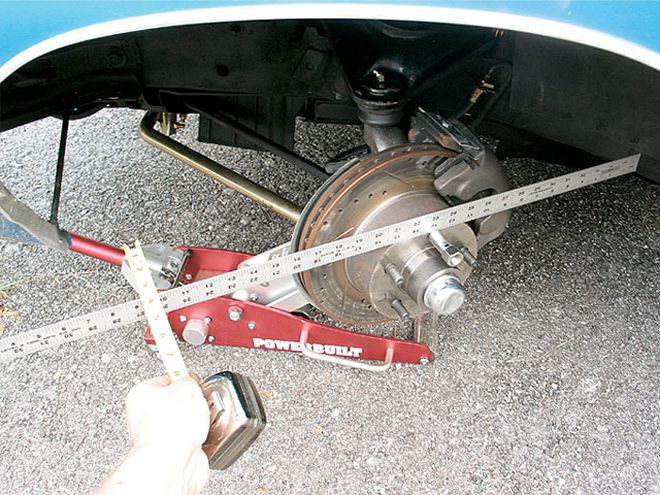 Depending on the diameter of the tire you wish to use, the front may need to be measured to ensure no interference with the lip of the fender. Note that our straight edge can't be centered on the front, so some interpolation must be used when measuring.<BR><BR><BR>
Depending on the diameter of the tire you wish to use, the front may need to be measured to ensure no interference with the lip of the fender. Note that our straight edge can't be centered on the front, so some interpolation must be used when measuring.<BR><BR><BR>
Additional Considerations
While we hope this tire fitment guide serves as a useful tool when determining the tires that will adorn your Mopar, there are many other resources available to help. A great way to figure out what tire-and-wheel combination will look good on your car is to find similar cars and look at their tires and wheels. If you're having trouble finding a car at your local shows or cruises don't forget to check out the pages of our magazine. We know the decision of a tire-and-wheel combination can be hard to make, so we try to print the tire and wheel size of each car featured in Mopar Muscle. Simply find a car the same body style as yours in our pages, and the Fast Facts page will give you the tire and wheel specifications of that car. Also, don't forget about your local tire store. Their employees can be helpful when considering tires and wheels for your ride. The tire manufacturers also have great web sites that can give a wealth of information about tire selection, construction, and use. Remember, though, that whatever tires you choose, the best way to show them off is by driving the car, and the best way to make sure they stay round is by smoking them to oblivion!